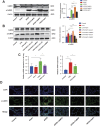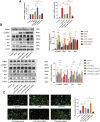Heliox preconditioning exerts pulmonary protection effects on neonatal acute respiratory distress syndrome by inhibiting oxidative stress and apoptosis
- PMID: 40894209
- PMCID: PMC12394224
- DOI: 10.3389/fphar.2025.1621190
Heliox preconditioning exerts pulmonary protection effects on neonatal acute respiratory distress syndrome by inhibiting oxidative stress and apoptosis
Abstract
Objective: This study aimed to investigate whether heliox preconditioning (HePC) alleviates neonatal acute respiratory distress syndrome (ARDS) by inhibiting oxidative stress and apoptosis, and to explore its potential mechanism.
Methods: Blood samples and bronchoalveolar lavage fluid (BALF) were collected from rat pups were randomly divided into control group, sham group, ARDS group, ARDS + CaMKII- group, ARDS + CaMKII+ group, and ARDS + HePC group. We also investigated the role of CaMKII by manipulating its expression in vitro. Inflammatory markers, oxidative stress, apoptosis and activation of signaling pathways were assessed using histological staining, ELISA, Western blotting, qRT-PCR, Ca2+, immunofluorescence staining, and flow cytometry.
Results: In vivo, HePC significantly reduced the expression of CaMKII, inhibited the activation of CaMKII/RyR2, ameliorated the LPS-induced lung histopathological changes in rat pups, reduced lung wet/dry ratios, ROS and MDA levels, and pro-inflammatory cytokine levels, and significantly increased the expression of antioxidant proteins (Nrf2, HO-1 and SOD) and reduced LPS-induced apoptosis. In vitro, overexpression of CaMKII increases oxidative stress and activates RyR2, leading to cytoplasmic Ca2+ overload and increased apoptosis. HePC can reverse the above reactions by inhibiting the expression of CaMKII.
Conclusion: HePC may attenuate oxidative stress through CaMKII and alleviate cytoplasmic Ca2+ overload by regulating CaMKII/RyR2, which inhibits apoptosis, exerting lung protection against ARDS.
Keywords: CaMK-II; anti-apoptosis; anti-oxidative stress; heliox preconditioning; neonatal acute respiratory distress syndrome.
Copyright © 2025 Ma, Shen and Shi.
Conflict of interest statement
The authors declare that the research was conducted in the absence of any commercial or financial relationships that could be construed as a potential conflict of interest.
Figures





References
-
- Bracken C., Beauverger P., Duclos O., Russo R. J., Rogers K. A., Husson H., et al. (2016). CaMKII as a pathological mediator of ER stress, oxidative stress, and mitochondrial dysfunction in a murine model of nephronophthisis. Am. J. Physiol. Ren. Physiol. 310 (11), F1414–F1422. 10.1152/ajprenal.00426.2015 - DOI - PubMed
-
- Chekole B., Fetene T. T., Geze T. S., Tefera Z. B., Alebel G. E. F., Kassaw A., et al. (2023). Prevalence and factors associated with neonatal acute respiratory distress syndrome among neonates admitted to the neonatal intensive care units of Gurage zone public hospital, south west Ethiopia. Afr. Health Sci. 23 (3), 159–167. 10.4314/ahs.v23i3.20 - DOI - PMC - PubMed
LinkOut - more resources
Full Text Sources
Miscellaneous

